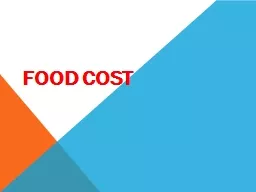

Food cost is defined as the percentage of total sales spent on food products in a restaurant A normal restaurants food cost is 2830 while that of a steakhouse is 35 Food Cost An Interpretation ID: 638964
Download Presentation The PPT/PDF document "Food Cost Food Cost Definition" is the property of its rightful owner. Permission is granted to download and print the materials on this web site for personal, non-commercial use only, and to display it on your personal computer provided you do not modify the materials and that you retain all copyright notices contained in the materials. By downloading content from our website, you accept the terms of this agreement.
Slide1
Food CostSlide2
Food Cost Definition
Food
cost
is defined as the percentage of total sales spent on food products in a restaurant
.
A normal
restaurant's food cost is 28-30% while that of a steakhouse is 35%.Slide3
Food Cost – An Interpretation
The food cost is directly proportional to the cost of food.
This implies that the higher the cost of ingredients, the higher will be the Food Cost %.
The higher the Food Cost %, the lower is your profit.
3Slide4
ASPECTS OF FOOD
COST
Essentially, there are three aspects of food cost that must be individually calculated for each operation:
Maximum allowable food cost percentage
Actual
Food
Cost percentage
- calculated for income statement
Potential Food Cost percentage
– determined by the menu sales mixSlide5
MAXIMUM ALLOWABLE FOOD
COST
It determines the food cost percentage an operation needs in order to achieve its profit objectives.
To calculate the maximum allowable food cost percentage, select a representative accounting period and determine the amounts for
:
Payroll related expenses (Salaries, wages, taxes, and fringe benefit)
Overhead expenses (advertising, utilities, maintenance, other supplies excluding food costs)Slide6
Calculate the operating budget and determine the amounts for the following:
Payroll and related expenses (e.g. wages, salaries, taxes, fringe benefits).
Overhead expenses (e.g. utilities, maintenance, advertising, supplies excluding= food costs).
Target figure for profit minus tax.Slide7
For example, if your budget is 26% payroll, 20% overhead and 15% profit, it's a total of 61%. Subtract that number by 100 to get your maximum allowable food cost. In this example, it's 39%.Slide8
ACTUAL FOOD
COST
The actual food cost percentage appears on the monthly income statement
.
This is the cost of the food consumed by your customers, and does not include employee meals or spoilage.
Although the actual food cost indicates what the food cost is currently running, it has little value unless the operator knows what the target percentage should be.Slide9
Food Cost % = (Beginning Inventory + Purchases - Ending Inventory) / Food SalesSlide10
For example, last week you ended up with a $10,000 inventory. This will be this week's opening inventory. (Beginning Inventory = $10,000
)
Add all purchases for the period.
In this example, let's say this week you bought $3,000 worth of products. Add that amount to the beginning inventory. That will give you a total of $13,000. ($10,000 + $3,000 = $13,000
)Slide11
For instance, you end up with inventory of $10,500 after selling your products. You will subtract that amount from $13,000. That gives you a theoretical value $2,500 in product for the week. ($13,000 - 10,500 = $2,500)Slide12
For example, you sold $6,500 this week. You divide $2,500 by your sale of $6,500. A percentage of that sale is calculated for food cost. That gives you 0.38 or 38%. That means you spent 0.38 cents for every dollar in sales or 38% cost of food. ($2,500 / $6,500 = 0.38 or 38%)Slide13
POTENTIAL FOOD COST
Potential food cost is a theoretical or ideal percentage which indicates what the food cost should be in a perfectly run restaurant, given the sales mix.
To calculate the food cost percentage of each dish:
Multiply the food cost per item with the number of portions sold
Multiply the sales price by the number of portions sold
Add both columns and then multiply the total cost by 100 and divide it by the total of the sales column.Slide14
Figure out your potential food cost with these formulas:
Cost per item multiplied by the number of items sold = total cost
Sales price multiplied by the number of items sold = total sales
Multiply the total cost by 100, the divide that number by the total sales
.Slide15
Cost per item multiplied by the number of items sold = total cost
Sales price multiplied by the number of items sold = total sales
Multiply the total cost by 100, the divide that number by the total sales.Slide16
Menu Pricing
Cost
per Portion
= Selling Price
Food Cost %Slide17
Menu Pricing
Cost per
Portion
Food Cost % Selling Price
$5,50 ÷ ,38 = $ 14.47 ($15)